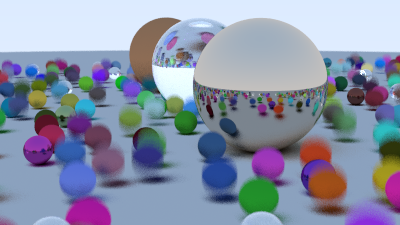1
2
3
4
5
6
7
8
9
10
11
12
13
14
15
16
17
18
19
20
21
22
23
24
25
26
27
28
29
30
31
32
33
34
35
36
37
38
39
40
41
42
43
44
45
46
47
48
49
50
51
52
53
54
55
56
57
58
59
60
61
62
63
64
65
66
67
68
69
70
71
72
73
74
75
76
77
78
79
80
81
82
83
84
85
86
87
88
89
90
91
92
93
94
95
96
97
98
99
100
101
102
103
104
105
106
107
108
109
110
111
112
113
114
115
116
117
118
119
120
121
122
123
124
125
| #include <iostream>
#include <string>
#include <omp.h>
#define STB_IMAGE_WRITE_IMPLEMENTATION
#include "stb_image_write.h"
#include "hittable_list.h"
#include "sphere.h"
#include "color.h"
#include "camera.h"
hittable_list random_scene() {
hittable_list world;
auto ground_material = make_shared<lambertian>(color(0.5, 0.5, 0.5));
world.add(make_shared<sphere>(
point3(0, -1000, 0), point3(0, -1000, 0), 0.0, 1.0, 1000, ground_material));
for (int a = -11; a < 11; a++) {
for (int b = -11; b < 11; b++) {
auto choose_mat = random_double();
point3 center(a + 0.9 * random_double(), 0.2, b + 0.9 * random_double());
if ((center - point3(4, 0.2, 0)).length() > 0.9) {
shared_ptr<material> sphere_material;
if (choose_mat < 0.8) {
auto albedo = random_vec() * random_vec();
sphere_material = make_shared<lambertian>(albedo);
auto center2 = center + vec3(0, random_double(0, 0.5), 0);
world.add(make_shared<sphere>(
center, center2, 0.0, 1.0, 0.2, sphere_material));
}
else if (choose_mat < 0.9) {
auto albedo = random_vec(0.5, 1);
auto fuzz = random_double(0, 0.5);
sphere_material = make_shared<metal>(albedo, fuzz);
world.add(make_shared<sphere>(
center, center, 0.0, 1.0, 0.2, sphere_material));
}
else {
sphere_material = make_shared<dielectric>(1.5);
world.add(make_shared<sphere>(
center, center, 0.0, 1.0, 0.2, sphere_material));
}
}
}
}
auto material1 = make_shared<dielectric>(1.5);
world.add(make_shared<sphere>(
point3(0, 1, 0), point3(0, 1, 0), 0.0, 1.0, 1.0, material1));
auto material2 = make_shared<lambertian>(color(0.4, 0.2, 0.1));
world.add(make_shared<sphere>(
point3(-4, 1, 0), point3(-4, 1, 0), 0.0, 1.0, 1.0, material2));
auto material3 = make_shared<metal>(color(0.7, 0.6, 0.5), 0.0);
world.add(make_shared<sphere>(
point3(4, 1, 0), point3(4, 1, 0), 0.0, 1.0, 1.0, material3));
return world;
}
int main()
{
std::string SavePath = "D:\\TechStack\\ComputerGraphics\\Ray Tracing in One Weekend Series\\Results\\The Next Week\\";
std::string filename = "MotionBlur.png";
std::string filepath = SavePath + filename;
const auto aspect_ratio = 16.0 / 9.0;
const int image_width = 400;
const int image_height = static_cast<int>(image_width / aspect_ratio);
const int channel = 3;
const int samples_per_pixel = 100;
const int min_bounce = 45;
const double RR = 0.9;
point3 lookfrom(13, 2, 3);
point3 lookat(0, 0, 0);
vec3 vup(0, 1, 0);
auto dist_to_focus = 10.0;
auto aperture = 0.1;
camera cam(lookfrom, lookat, vup, 20, aspect_ratio, aperture, dist_to_focus, 0.0, 1.0);
auto world = random_scene();
unsigned char* odata = (unsigned char*)malloc(image_width * image_height * channel);
unsigned char* p = odata;
for (int j = image_height - 1; j >= 0; --j) {
std::cerr << "\rScanlines remaining: " << j << ' ' << std::flush;
for (int i = 0; i < image_width; ++i) {
color pixel_color(0, 0, 0);
for (int s = 0; s < samples_per_pixel; ++s) {
auto u = (i + random_double()) / (image_width - 1);
auto v = (j + random_double()) / (image_height - 1);
ray r = cam.get_ray(u, v);
pixel_color += ray_color(r, world, min_bounce, RR);
}
write_color(p, pixel_color, samples_per_pixel);
}
}
stbi_write_png(filepath.c_str(), image_width, image_height, channel, odata, 0);
std::cerr << "\nDone.\n";
}
|
